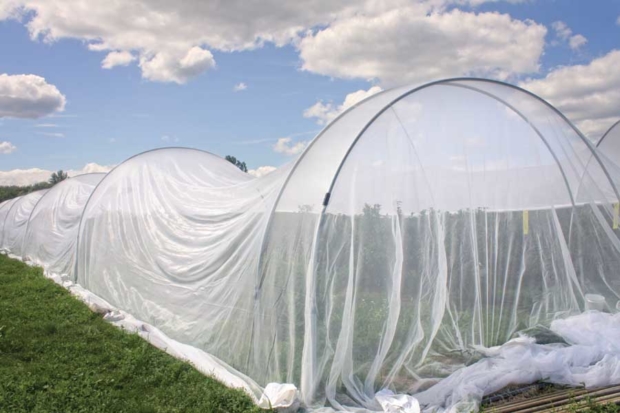
Organic researchers are evaluating various kinds of materials to separate insects from fruit, such as this netting in a Stephentown, New York, blueberry field. They found no difference in temperature inside and outside the structure, only a slight increase in relative humidity inside and said insect exclusion results were “encouraging.” So, too, are the results of a similar test of this netting by a group of scientists near Montreal, Quebec. (Courtesy of Greg Loeb, Cornell University-Geneva)
Researchers are tackling what they call “cultural tactics” to determine nonchemical farming practices — such as pruning and thinning techniques or netting — that can be brought into play to thwart spotted wing drosophila in organic orchards, vineyards and fields.
In one project of blueberries and raspberries, researchers plan to adjust the temperature and humidity inside the canopy, where the insects mate and reproduce. “How can we use pruning to open the canopy to more light? Can we create a less favorable habitat?” said Dr. Mary Rogers, University of Minnesota entomologist and organic project co-director.
They plan to evaluate the effects of pruning 20 percent and 50 percent of the canopy, as well as thinning at 6 inches apart, 9 inches apart and 12 inches apart, on the microclimate inside the canopy.
Another effort focuses on the developmental stages of the fly. It is hard to find spotted wing drosophila pupates, Rogers said. “Do they use soil as a breeding reservoir? Do they move into it?”
Acting on the assumption they do, project director, Dr. Ash Sial, a University of Georgia entomologist, said they plan to evaluate various mulches, plastics and landscape netting for their abilities to create barriers to the soil — a tactic called orchard floor management.
“We know certain mulches can raise temperatures. We’ll be testing woven net versus pine mulch,” Rogers said.
They will also be testing weed mats. “We will evaluate some heavier plastic products to see if they can prevent the insects from penetrating the soil. Another one is a highly reflective material, which can create a high heat to burn them,” Sial said.
Fabric barriers can be effective, but are more applicable to smaller scale farms, he said.
After a year of planning, this year they’ll begin testing these ideas in farm fields on the scale of normal organic production. Later in the season, they will be demonstrating those practices and results in on-farm field days and demonstrations.
For more information about this project, visit its website at: bit.ly/1XHWVkw
Netting
Dr. Greg Loeb, a Cornell University entomology researcher, has been involved in a multi-year project to determine if netting can effectively exclude spotted wing drosophila from small fruit.
“We know that exclusion netting, netting that is very fine, has been pretty successful for Eastern blueberry growers when put up at ripening with no spraying,” he said.
Raspberries are another story. Because these fruit are flowering and ripening at the same time, some provision must be made for pollination.
Thus far, he and his team have determined 80g nets with holes no wider than 1 millimeter will exclude the fly. “It also allows good airflow and allows plenty of light to facilitate growing,” Loeb said.
Is netting a good investment? It costs $4,600 to net one-half acre, plus the cost of custom sewing to make 26-foot wide sections.
Loeb says his research is looking at that question right now. One of the growers he’s working with says she thinks netting can be stored for up to 10 years if stored in UV bags.
This summer, they plan to test the use of the netting in fall raspberries. In addition, they will look at how to rescue a netted section if spotted wing drosophila penetrates it. •
– by Dave Weinstock






Leave A Comment